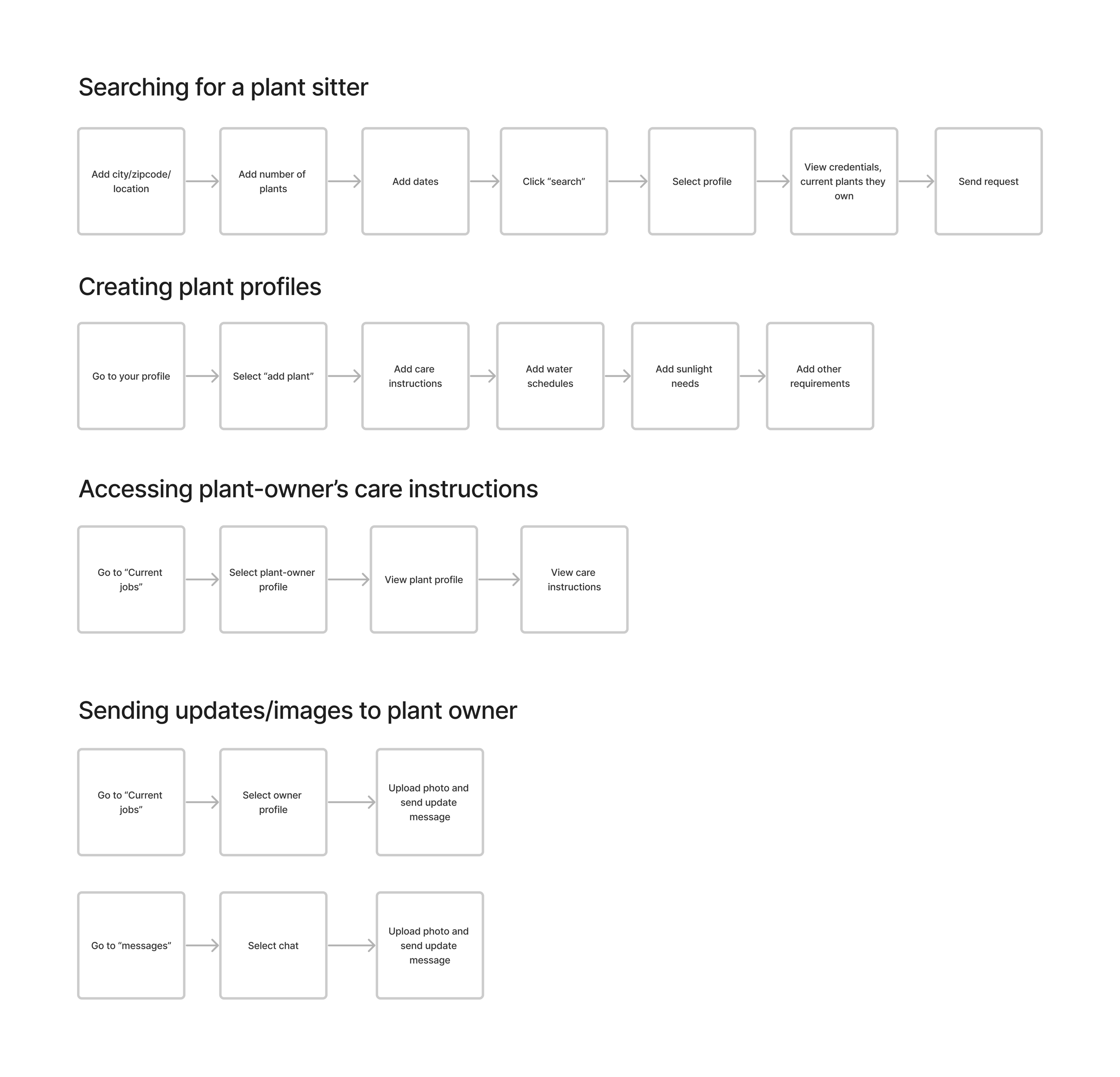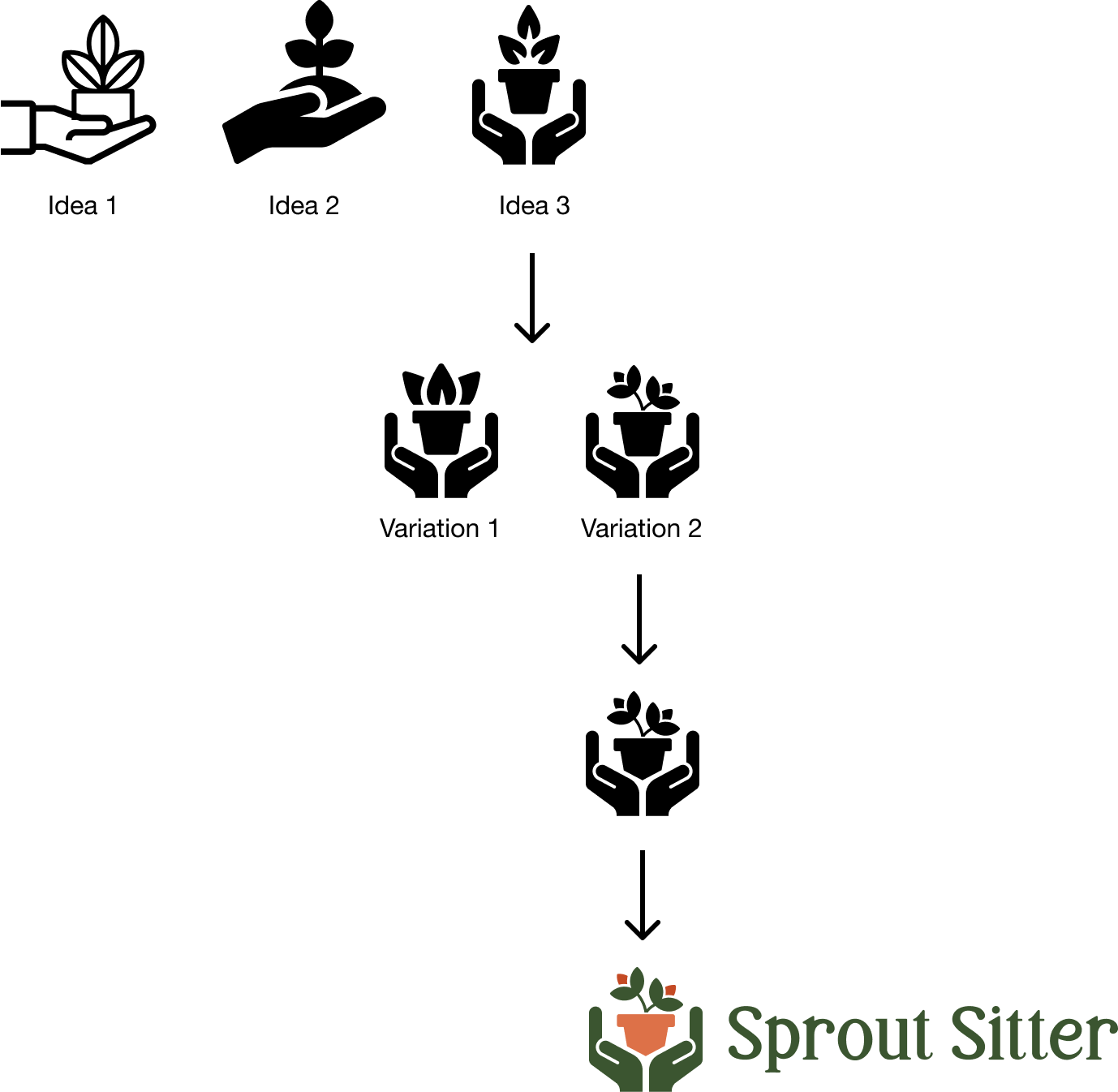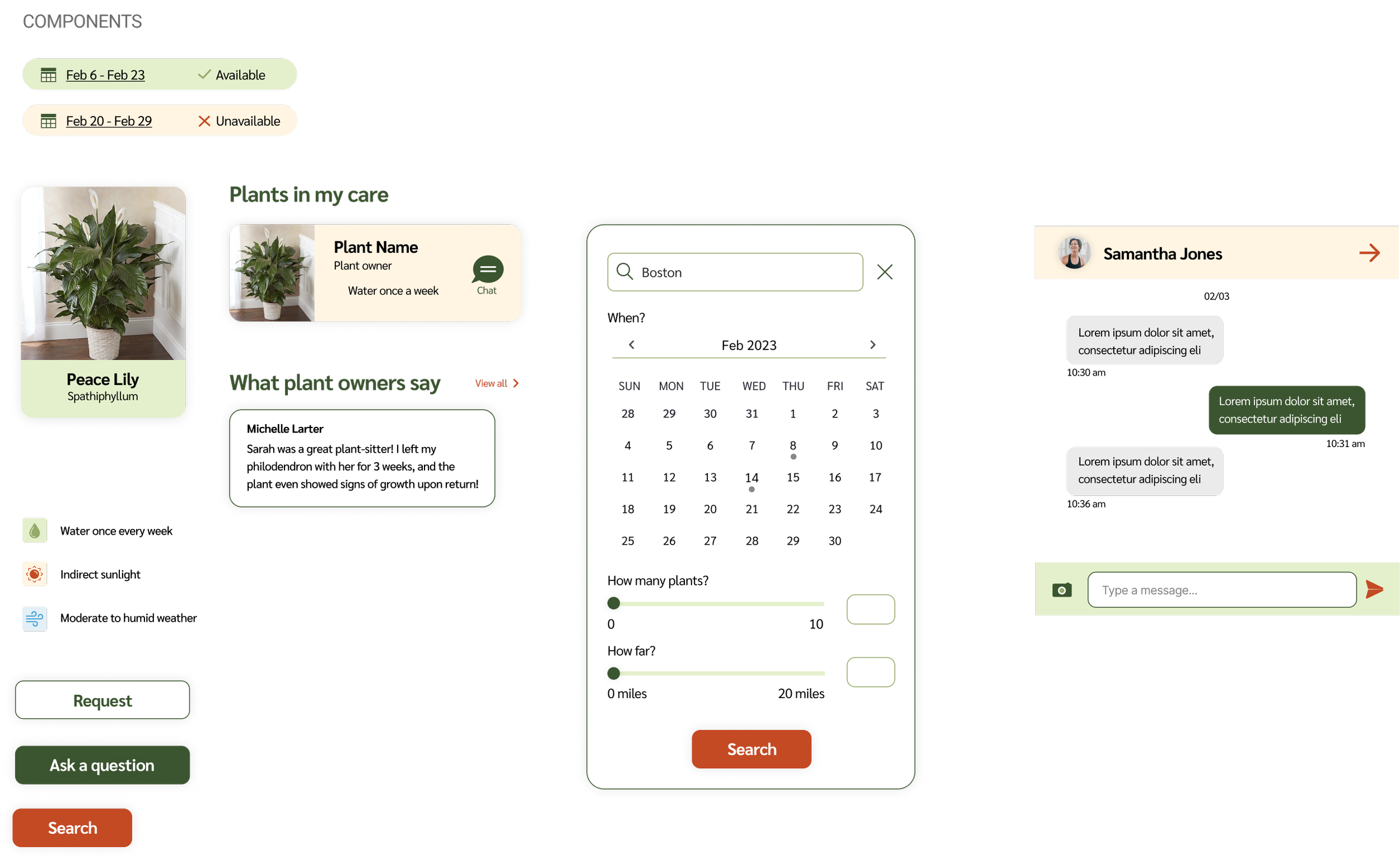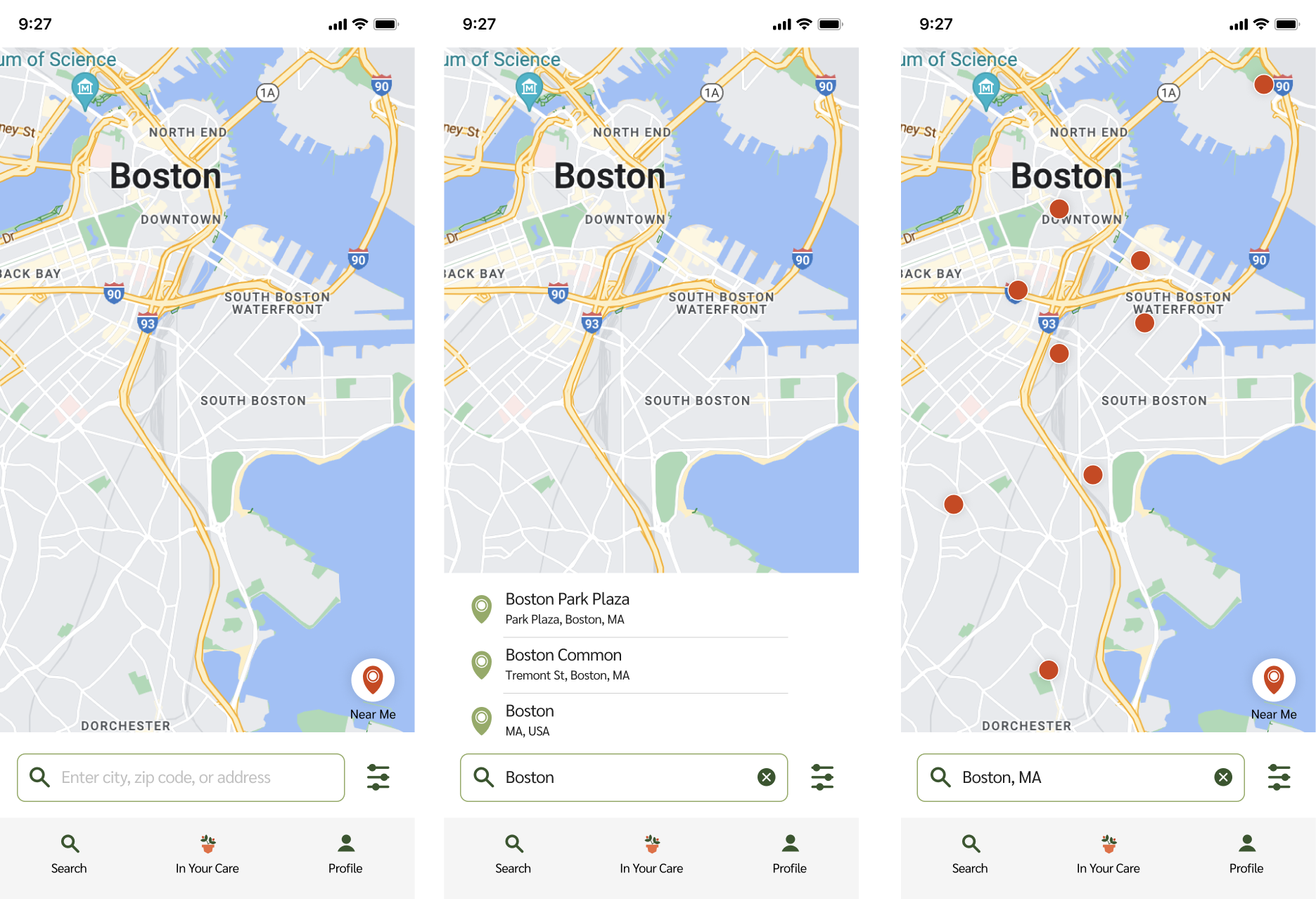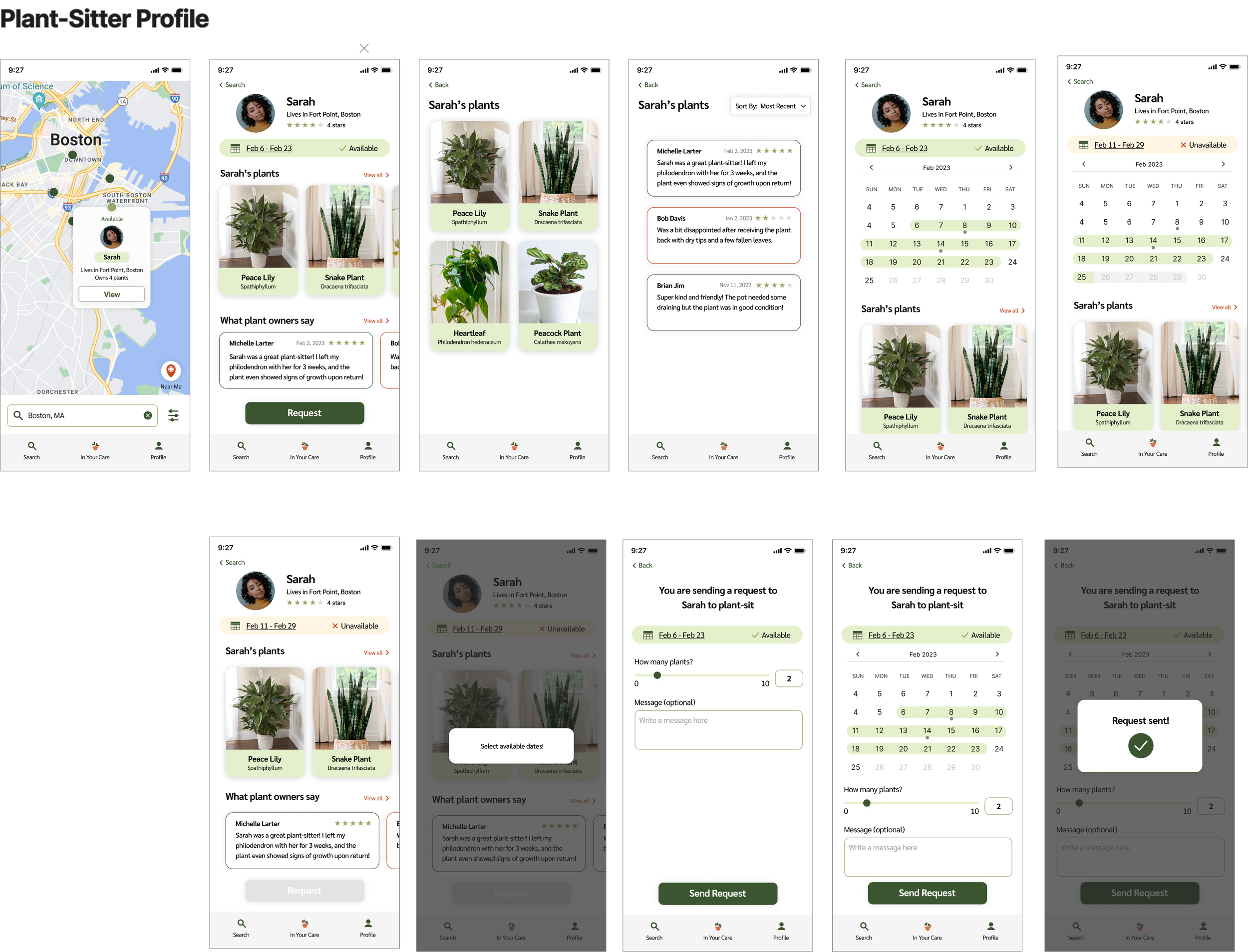Case Study: End-to-End Application
UX Academy Course 2023
Research
House plants can be difficult to care for correctly. Similar to pets, plants need to be taken care of even when their owners are away. Personally, I have heard accounts of plants either dying while their owners were gone for vacation, or poorly taken care of by friends, family members or roommates. The aim of my research was to discover problems plant owners face when it comes to ensuring their plants thrive while they are not around to care for them.
What is the average number of days that plant-owners travel a year?
What is the age range of plant-owners? Are they tech savy?
What percentage of plant owners worry about their plant’s health while they’re away?
What are the concerns about houseplants when travelling?
What do plant owners care about most when they ask someone to take care of their plant?
Who do plant-owners usually give their plant to take care of?
How do people find information on how to take care of a plant?
Objectives
Method
Interviews & Surveys
With insights from the surveys and interviews, I wanted to know what other platforms in the plant-sitting space have to offer. I looked into houseplantsitter.com and the Watering Can App, to see what their strengths and weaknesses are, in relation to what the interviews and surveys showed me about the pain points and concerns of plant owners.
In summary, existing platforms such as Houseplantsitter and Water Can offer plant-owners a way to make sure their plants are cared for by knowledgable and trusted people while they are away, however there are limitations. Houseplantsitter’s reach is limited to Austin, TX and it is unclear whether their employees require access to a person’s home. The Watering Can app’s user experience is poor, as it is full of bugs in general. Upon further research, it seems that the company has transitioned more towards becoming a plant education platform rather than a plant-sitter-finding platform.
Key Insights:
The affinity map indicated a lot of concerns about over and under-watering. Similarly, there were concerns about ensuring the correct amount sunlight and air conditions, but slightly less of a concern than watering. Another recurring theme was the inability to fully trust others to properly care for their plants. In terms of tech-savviness, participants considered themselves either fairly tech savvy or more tech savvy, and all participants have mentioned using the internet to find plant-care information in one way or another.
The survey results concluded that:
To gain a better insight of how plant-owners feel about caring for their plants, I conducted interviews on 3 plant-owners, and asked questions revolving around the research objectives. The responses were then gathered into an affinity map so that we could see general themes of issues that plant-owners faced:
Surveys were also conducted on 12 participants to efficiently collect quantitative and qualitative data on participants, such as:
General age range of plant sitters
How many plants they own
How many weeks a year they travel
Who they give their plants to
If they do or do not worry about their plant’s health while travelling
After seeing what competitors had to offer, I believed there could be a better way to help plant-lovers find someone credible and trustworthy to take care of their plants, with no worries (i.e having to provide strangers access to their homes) With the perspectives and concerns of plant-owners gathered from surveys and interviews, I narrowed down the point-of-view statements and how-might-we solutions to the following:
POV Statement: Plant-owners who plan to travel, need a way to find a way to have their plants taken care of by someone who is familiar with plant caring because they worry about their plants health while they are away
How might we build credibility of plant sitters?
How might we efficiently share plant care instructions (watering, sunlight, environment)?
How might we keep plant owners updated on the well-being of their plants?
How might we build familiarity between plant-owners/sitters?
With the POV and HMW statements finalized, I developed user persona based on the demographics of interview participants, which highlighted common user goals, needs, and pain points. This persona represented the target audience for the product throughout the ideation and development process.
Ideation
To brainstorm ideas, I used the analogous inspiration technique to look for solutions in different contexts that may be applicable to the problems of the user persona, and to help inspire ideas.
I chose to move forward with the first idea, because plant-owners would feel more comfortable finding a plant-sitter in their area and being able to bring it to them, rather than providing them with keys to their house. The second idea was more of a physical solution rather than digital.
Idea: A platform that allows users to search for plant-sitters available in their area.
Name: Plant Sitter / Plant Sit / Plant Hotel / Plantel
Who is it for? Plant-owners who are travelling for more than a week, who need somone to take care of their houseplant.
What does it accomplish for them? It allows them to find a plant-sitter to keep their plant alive, so that they to have a worry-free vacation/work trip.
How does it accomplish this? Shows plant-sitter profiles in their area (map)
Plant-sitter profiles provide:
Experience with plants, what plants they own. This plant-owners see if they similar species of plants.
Ratings and reviews from other plant owners
Availability calendar
Communicate and share photos of plant progress
Create plant profiles of your own plants (with added care instructions, amount of light needed, watering specifications etc.)
With the idea finalized, I created a storyboard to illustrate how the app would be utilized and how it solves the problems as described in the user persona.
I then developed a set of user and task flows that would layout how the platform would flow, and which screens needed to be designed.
User Flows
Information Architecture
User Feedback
The mid-fidelity wireframes were developed and tested by 3 participants using the Figma prototype link. Users were asked to download the Figma app to their mobile device and work through the following tasks from either a plant-owner or plant-sitter perspective:
As plant-owner, search for a plant sitter in Boston from Feb 6 - 23
As plant-owner, request to book Sarah’s profile
As a plant-sitter, view care instructions for the Orchid plant you are currently taking care of
As a plant-sitter, send update photos to Sam Jones via chat
All participants were able to complete their tasks, although there were some hesitancies along the way. The different issues recorded in the feedback were then organized into a prioritization matrix, so that we could improve the user flow in the high-fidelity prototypes.
Low-Fidelity Wireframes
I started by sketching mobile layout ideas for the Plant Sitter App feature, and how the Friends list would appear when users share content or add collaborators to playlists.
Mid-Fidelity Wireframes [Figma]
Branding
Before developing the high-fidelity wireframes, I put together a mood board which included brand values and visuals that were relevant to the user persona. The brand design is inspired by being calm, nature-loving, friendly, and transparent. I was also inspired by this vibrant graphic that depicts people watering their houseplants. The logo, which is a graphic of of hands carrying a plant, was inspired by the idea of caring for plants.
With the mid-fidelity wireframes and an inspiration for branding in mind, I developed a component library.
High-Fidelity Prototypes
Recommendations
Based on the analysis of feedback, the following recommendations were determined.
As users mentioned there should be a way to quickly search within the area, a “Near me” button to conduct a quick search within the location added. Also, suggestions would show up as the user types within the search box. Once the correct location appears in the suggestion, they can select a location to show results. This eliminates the need for a search button, or any users looking for a search button.
There seemed to be a lot of confusion about how to navigate the app from the perspective of a plant-sitter managing their jobs vs. the perspective of a plant-owner searching for plant-sitters around them. With the new icons added to the nav bar, users can easily flip through the “Search” and “In Your Care” sections. The “Profile” section is where plant-sitters can organize their plant profiles, adjust available dates, and other settings.
Users were having trouble finding care instructions for the plant they were taking care of. The “Plants in my care” page was reorganized to list jobs by earliest to latest return date. The plant-sitter would be able to scroll through the tiles under each owner, and select them to find information. Under each owner’s section, there is also a Chat button in which sitters can ask questions or send update photos.
Participants suggested adding confirmation page after requesting a plant-sitter. A series of pages were added after a user selects “Book” to confirm all the booking information such as dates, number of plants were added correctly, as well as the option to add a message to the sitter.
If a plant-owner selects dates which the plant-owner is not available on, it will not allow them to request, and instead display a “select available dates!” pop up.
Participants also suggested more information on the reviews. A color system was implemented to the reviews, to show positive reviews in green (3 stars and above) and negative reviews (2 stars or less). Also in the high-fidelity wireframes, I added a view more page, in which the reviews can be sorted differently.
Concluding Thoughts
Reflections
It would have been useful to conduct user feedback sessions on the SproutSitter high-fidelity prototypes. However, I felt there wasn’t enough time given the deadline of this final case study.
Additionally, I think it would have been useful for the plant-sitter profiles to list what plants they have taken care of previously. Although a plant-sitter may not own a certain plant species themselves, they may have had experience taking care of it previously, which plant-owners would be able to see and help make their decision. It would also be helpful to have a place on the plant profile to mention whether they charge a weekly fee per houseplant.
Next Steps
The next feature to build out would be the profile section, in which plant-sitter can adjust the plants they own, as well as available dates, and profile photo. This feature would also be where the notifications or messages would appear.










